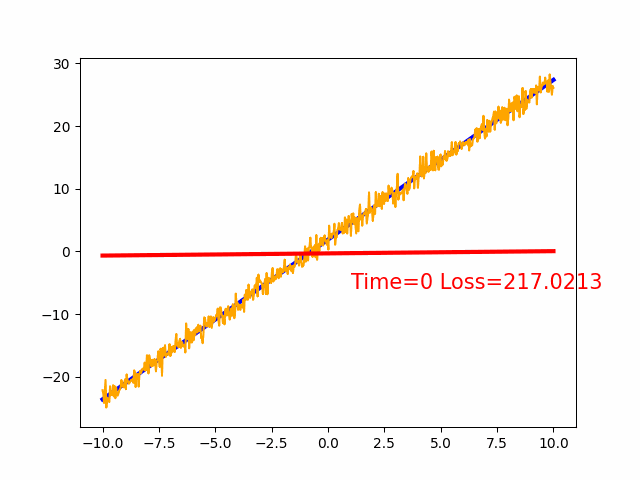1
2
3
4
5
6
7
8
9
10
11
12
13
14
15
16
17
18
19
20
21
22
23
24
25
26
27
28
29
30
31
32
33
34
35
36
37
38
39
40
41
42
43
44
45
46
47
48
49
50
51
52
53
54
55
56
57
58
59
60
61
62
| import torch
from torch import optim
from torch import nn
from matplotlib import pyplot as plt
import matplotlib.animation as animation
inputs = torch.unsqueeze(torch.linspace(-10,10, 600),dim=1)
targets = 2.55*inputs + 1.89 + torch.normal(0, 1, inputs.shape)
real = 2.55*inputs + 1.89
class NetWork(nn.Module):
def __init__(self):
super(NetWork,self).__init__()
self.linear = torch.nn.Linear(1,1)
def forward(self,x):
x = self.linear(x)
return x
network = NetWork()
loss_fn = nn.MSELoss()
optimizer = optim.SGD(network.parameters(),lr=0.001)
fig, ax = plt.subplots()
ims = []
for i in range(101):
out = network(inputs)
loss = loss_fn(out,targets)
optimizer.zero_grad()
loss.backward()
optimizer.step()
if i%2 == 0:
frame0, = ax.plot(inputs.numpy(),real.numpy(),c='blue',lw='3')
frame1, = ax.plot(inputs.numpy(),targets.numpy(),c='orange')
frame2, = ax.plot(inputs.numpy(),out.data.numpy(),c='red',lw='3')
title = ax.text(1, -6, 'Time=%d Loss=%.4f' % (i, loss.data.numpy()), fontdict={'size': 15, 'color': 'red'})
ims.append([frame0,frame1,frame2,title])
ani = animation.ArtistAnimation(fig, ims, interval=50, blit=False,
repeat_delay=1000)
ani.save('dynamic_images.gif')
|
